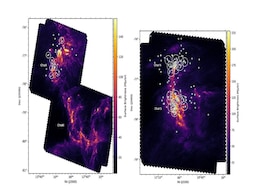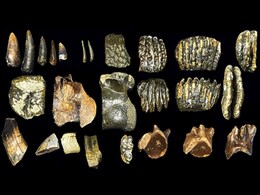Early Evolution
- All
- News
- Videos
-

James Webb Telescope May Have Spotted First Generation of Stars in the Universe
- Sunday November 16, 2025
- Written by Gadgets 360 Staff
Astronomers using JWST may have discovered Population III stars in cluster LAP1-B, offering new insights into early galaxy formation and the universe’s first luminous objects. JWST observations suggest Population III stars may have formed 13 billion years ago, helping trace early galaxies. These stars might be building blocks for larger galaxies ...
-
 www.gadgets360.com
www.gadgets360.com
-

Mars Once Had Changing Lakes: NASA Reveals Signs Of Life-Friendly Water Phases In Jezero Crater
- Tuesday November 11, 2025
- Science | Edited by Astitva Raj
As Mars's atmosphere changed, Jezero's water gradually became less acidic and more balanced.
-
 www.ndtv.com
www.ndtv.com
-

James Webb Telescope Finds Early Universe Galaxies Were More Chaotic Than We Thought
- Thursday October 23, 2025
- Written by Gadgets 360 Staff
The James Webb Space Telescope has revealed that galaxies in the early universe were far more chaotic and unstable than once believed. A new study shows that gas turbulence and intense star formation disrupted young galaxies, reshaping scientists’ understanding of how galaxies evolved into the structured systems seen today.
-
 www.gadgets360.com
www.gadgets360.com
-

Volcanoes Help Untangle Evolution Of Humans, Here's How
- Tuesday September 16, 2025
- World News | The Conversation
How did humans become human? Understanding when, where and in what environmental conditions our early ancestors lived is central to solving the puzzle of human evolution.
-
 www.ndtv.com
www.ndtv.com
-

Earliest Known Black Hole Found Just 500 Million Years After the Big Bang
- Friday August 8, 2025
- Written by Gadgets 360 Staff
Astronomers have confirmed the most distant black hole ever discovered, lurking in a compact galaxy just 500 million years after the Big Bang. Using the James Webb Space Telescope, the team identified clear spectroscopic evidence of the object, offering new insight into early black hole growth and their role in forming galaxies during the universe...
-
 www.gadgets360.com
www.gadgets360.com
-

NASA’s Hubble and Webb Discover Bursting Star Formation in Small Magellanic Cloud
- Saturday July 12, 2025
- Written by Gadgets 360 Staff
NASA’s Hubble and Webb telescopes have captured spectacular images of NGC 460 and NGC 456, two star clusters in the Small Magellanic Cloud. These young, open clusters are filled with massive, hot stars that trigger new star formation by carving nebulae. The findings provide insights into early universe conditions and interstellar medium behaviour...
-
 www.gadgets360.com
www.gadgets360.com
-

Hubble Observations Give Forgotten Globular Cluster Its Moment to Shine
- Saturday July 5, 2025
- Written by Gadgets 360 Staff
NASA’s Hubble Space Telescope has unveiled ESO 591-12, a long-overlooked globular cluster glittering with multicolored stars. Captured during a survey of missing clusters, this image provides new insight into stellar evolution and the early Milky Way. It marks a vital step in resolving the structure and origin of ancient star systems hidden withi...
-
 www.gadgets360.com
www.gadgets360.com
-

Very Massive Stars Blow Away Outer Layers in Powerful Winds Before Black Hole Collapse
- Saturday July 5, 2025
- Written by Gadgets 360 Staff
Massive stars may lose much more mass than expected before collapsing into black holes. A new study reveals that their powerful stellar winds strip outer layers early, reshaping theories of star evolution, black hole formation, and gravitational wave events. This research challenges previous models and helps explain observed features of stars like ...
-
 www.gadgets360.com
www.gadgets360.com
-

Webb Telescope Spots Possible Jellyfish Galaxy 12 Billion Light-Years Away
- Thursday July 3, 2025
- Written by Gadgets 360 Staff
Astronomers using the James Webb Space Telescope have identified a possible jellyfish galaxy about 12 billion light-years away. Named COSMOS2020-635829, it shows tentacle-like streams of gas and stars trailing off one side—likely formed through ram pressure stripping in a dense cluster. If confirmed, it would be the most distant jellyfish galaxy ...
-
 www.gadgets360.com
www.gadgets360.com
-

Radio Observations in Chamaeleon Cloud Reveal Five Young Stars, Including a Binary System
- Thursday July 3, 2025
- Written by Gadgets 360 Staff
A team of astronomers using the Australia Telescope Compact Array (ATCA) discovered five young stars in the Chamaeleon cloud complex. One is a probable tight binary system. These findings enhance our understanding of early stellar evolution and the structure of southern star-forming regions.
-
 www.gadgets360.com
www.gadgets360.com
-

Radio Signal from Early Universe May Reveal the Masses of the First Stars
- Sunday June 22, 2025
- Written by Gadgets 360 Staff
A newly modelled 21-centimetre radio signal from hydrogen atoms just 100 million years after the Big Bang may reveal the mass of the universe’s first stars. Using REACH and the upcoming SKA telescopes, researchers aim to uncover how early starlight shaped cosmic evolution during the Cosmic Dawn, when the universe transitioned from darkness to lig...
-
 www.gadgets360.com
www.gadgets360.com
-

Archaeologists Discover Three Lost Maya Cities in Guatemala’s Jungle
- Monday June 9, 2025
- Written by Gadgets 360 Staff
Archaeologists from Slovakia and Guatemala have unearthed three previously unknown Maya cities in Guatemala’s Petén jungle. The sites—Los Abuelos, Petnal, and Cambrayal—feature ceremonial statues, pyramids, astronomical alignments, and advanced water engineering. Highlights include ancestral altars, a 108-foot pyramid, and a palace with a ro...
-
 www.gadgets360.com
www.gadgets360.com
-

7,100-Year-Old Skeleton Reveals Unknown Human Lineage in China
- Saturday May 31, 2025
- Written by Gadgets 360 Staff
A groundbreaking study of a 7,100-year-old skeleton found in Yunnan, China, has revealed a "ghost" human lineage previously known only through genetic inference. The woman, named Xingyi_EN, belonged to a deeply divergent group called the Basal Asian Xingyi lineage, which may have contributed to modern Tibetan ancestry. This discovery, along with ev...
-
 www.gadgets360.com
www.gadgets360.com
-

New Homo Erectus Fossils Reveal Ancient Migration Across Drowned Sundaland
- Tuesday May 27, 2025
- Written by Gadgets 360 Staff
Two Homo erectus skull fragments recovered from the seafloor near Java have rewritten the species' migration story. Once thought isolated to Java, H. erectus likely roamed the now-submerged plains of Sundaland 140,000 years ago. These ancient humans hunted turtles and large mammals and may have adopted modern hunting techniques, possibly through cu...
-
 www.gadgets360.com
www.gadgets360.com
-

Jupiter Was Once Twice Its Size - And Its Magnetic Field Could Fry Spacecraft
- Thursday May 22, 2025
- Science | Edited by Nikhil Pandey
Jupiter's early evolution and gravitational influence played a crucial role in shaping the solar system's structure and planetary orbits, earning it the title of the solar system's "architect."
-
 www.ndtv.com
www.ndtv.com
-

James Webb Telescope May Have Spotted First Generation of Stars in the Universe
- Sunday November 16, 2025
- Written by Gadgets 360 Staff
Astronomers using JWST may have discovered Population III stars in cluster LAP1-B, offering new insights into early galaxy formation and the universe’s first luminous objects. JWST observations suggest Population III stars may have formed 13 billion years ago, helping trace early galaxies. These stars might be building blocks for larger galaxies ...
-
 www.gadgets360.com
www.gadgets360.com
-

Mars Once Had Changing Lakes: NASA Reveals Signs Of Life-Friendly Water Phases In Jezero Crater
- Tuesday November 11, 2025
- Science | Edited by Astitva Raj
As Mars's atmosphere changed, Jezero's water gradually became less acidic and more balanced.
-
 www.ndtv.com
www.ndtv.com
-

James Webb Telescope Finds Early Universe Galaxies Were More Chaotic Than We Thought
- Thursday October 23, 2025
- Written by Gadgets 360 Staff
The James Webb Space Telescope has revealed that galaxies in the early universe were far more chaotic and unstable than once believed. A new study shows that gas turbulence and intense star formation disrupted young galaxies, reshaping scientists’ understanding of how galaxies evolved into the structured systems seen today.
-
 www.gadgets360.com
www.gadgets360.com
-

Volcanoes Help Untangle Evolution Of Humans, Here's How
- Tuesday September 16, 2025
- World News | The Conversation
How did humans become human? Understanding when, where and in what environmental conditions our early ancestors lived is central to solving the puzzle of human evolution.
-
 www.ndtv.com
www.ndtv.com
-

Earliest Known Black Hole Found Just 500 Million Years After the Big Bang
- Friday August 8, 2025
- Written by Gadgets 360 Staff
Astronomers have confirmed the most distant black hole ever discovered, lurking in a compact galaxy just 500 million years after the Big Bang. Using the James Webb Space Telescope, the team identified clear spectroscopic evidence of the object, offering new insight into early black hole growth and their role in forming galaxies during the universe...
-
 www.gadgets360.com
www.gadgets360.com
-

NASA’s Hubble and Webb Discover Bursting Star Formation in Small Magellanic Cloud
- Saturday July 12, 2025
- Written by Gadgets 360 Staff
NASA’s Hubble and Webb telescopes have captured spectacular images of NGC 460 and NGC 456, two star clusters in the Small Magellanic Cloud. These young, open clusters are filled with massive, hot stars that trigger new star formation by carving nebulae. The findings provide insights into early universe conditions and interstellar medium behaviour...
-
 www.gadgets360.com
www.gadgets360.com
-

Hubble Observations Give Forgotten Globular Cluster Its Moment to Shine
- Saturday July 5, 2025
- Written by Gadgets 360 Staff
NASA’s Hubble Space Telescope has unveiled ESO 591-12, a long-overlooked globular cluster glittering with multicolored stars. Captured during a survey of missing clusters, this image provides new insight into stellar evolution and the early Milky Way. It marks a vital step in resolving the structure and origin of ancient star systems hidden withi...
-
 www.gadgets360.com
www.gadgets360.com
-

Very Massive Stars Blow Away Outer Layers in Powerful Winds Before Black Hole Collapse
- Saturday July 5, 2025
- Written by Gadgets 360 Staff
Massive stars may lose much more mass than expected before collapsing into black holes. A new study reveals that their powerful stellar winds strip outer layers early, reshaping theories of star evolution, black hole formation, and gravitational wave events. This research challenges previous models and helps explain observed features of stars like ...
-
 www.gadgets360.com
www.gadgets360.com
-

Webb Telescope Spots Possible Jellyfish Galaxy 12 Billion Light-Years Away
- Thursday July 3, 2025
- Written by Gadgets 360 Staff
Astronomers using the James Webb Space Telescope have identified a possible jellyfish galaxy about 12 billion light-years away. Named COSMOS2020-635829, it shows tentacle-like streams of gas and stars trailing off one side—likely formed through ram pressure stripping in a dense cluster. If confirmed, it would be the most distant jellyfish galaxy ...
-
 www.gadgets360.com
www.gadgets360.com
-

Radio Observations in Chamaeleon Cloud Reveal Five Young Stars, Including a Binary System
- Thursday July 3, 2025
- Written by Gadgets 360 Staff
A team of astronomers using the Australia Telescope Compact Array (ATCA) discovered five young stars in the Chamaeleon cloud complex. One is a probable tight binary system. These findings enhance our understanding of early stellar evolution and the structure of southern star-forming regions.
-
 www.gadgets360.com
www.gadgets360.com
-

Radio Signal from Early Universe May Reveal the Masses of the First Stars
- Sunday June 22, 2025
- Written by Gadgets 360 Staff
A newly modelled 21-centimetre radio signal from hydrogen atoms just 100 million years after the Big Bang may reveal the mass of the universe’s first stars. Using REACH and the upcoming SKA telescopes, researchers aim to uncover how early starlight shaped cosmic evolution during the Cosmic Dawn, when the universe transitioned from darkness to lig...
-
 www.gadgets360.com
www.gadgets360.com
-

Archaeologists Discover Three Lost Maya Cities in Guatemala’s Jungle
- Monday June 9, 2025
- Written by Gadgets 360 Staff
Archaeologists from Slovakia and Guatemala have unearthed three previously unknown Maya cities in Guatemala’s Petén jungle. The sites—Los Abuelos, Petnal, and Cambrayal—feature ceremonial statues, pyramids, astronomical alignments, and advanced water engineering. Highlights include ancestral altars, a 108-foot pyramid, and a palace with a ro...
-
 www.gadgets360.com
www.gadgets360.com
-

7,100-Year-Old Skeleton Reveals Unknown Human Lineage in China
- Saturday May 31, 2025
- Written by Gadgets 360 Staff
A groundbreaking study of a 7,100-year-old skeleton found in Yunnan, China, has revealed a "ghost" human lineage previously known only through genetic inference. The woman, named Xingyi_EN, belonged to a deeply divergent group called the Basal Asian Xingyi lineage, which may have contributed to modern Tibetan ancestry. This discovery, along with ev...
-
 www.gadgets360.com
www.gadgets360.com
-

New Homo Erectus Fossils Reveal Ancient Migration Across Drowned Sundaland
- Tuesday May 27, 2025
- Written by Gadgets 360 Staff
Two Homo erectus skull fragments recovered from the seafloor near Java have rewritten the species' migration story. Once thought isolated to Java, H. erectus likely roamed the now-submerged plains of Sundaland 140,000 years ago. These ancient humans hunted turtles and large mammals and may have adopted modern hunting techniques, possibly through cu...
-
 www.gadgets360.com
www.gadgets360.com
-

Jupiter Was Once Twice Its Size - And Its Magnetic Field Could Fry Spacecraft
- Thursday May 22, 2025
- Science | Edited by Nikhil Pandey
Jupiter's early evolution and gravitational influence played a crucial role in shaping the solar system's structure and planetary orbits, earning it the title of the solar system's "architect."
-
 www.ndtv.com
www.ndtv.com






















